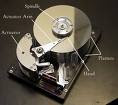The kernel in computer system is the central component of the operating system. The kernel has several vital functions in computing. Its responsibilities include managing the system's resources such as the computer hardware and software. The kernel is basically used to hold applications that are not user friendly. It acts as the media of communication between the system hardware and software. In a typical computing architecture the operating system and the application software rest on the kernel. Below the kernel are the system assembles, firmware and then the hardware.
As a basic component of an operating system, a kernel provides the lowest-level abstraction layer for the resources especially memory, processors and I/O devices that application software must control to perform its function. It typically makes these facilities available to application processes through inter-process communication mechanisms and system calls
Kernel development is considered one of the most complex and difficult tasks in programming. Its central position in an operating system implies the necessity for good performance, which defines the kernel as a critical piece of software and makes its correct design and implementation difficult. For various reasons, a kernel might not even be able to use the abstraction mechanisms it provides to other software. Such reasons include memory management concerns (for example, a user-mode function might rely on memory being subject to demand paging, but as the kernel itself provides that facility it cannot use it, because then it might not remain in memory to provide that facility) and lack of reentrancy, thus making its development even more difficult for software engineers
Friday, June 26, 2009
Thursday, June 11, 2009
LCD Monitors Technology
LCD- Acronym for Liquid Crystal Display is some of the latest advancements made in computer technology. This technology was introduced to computers with notebooks. LCD monitors technology is based on liquid crystal acting like shutters where they allow light to either pass through or block it. LCDs provide finer quality because they there is no alteration from analog to digital.
LCD works/functions in a more unique way than the primitive CRT monitors. An LCD panel consists of five layers.
1. White back light that provides the illumination.
2. Polarizing filter that ensures the light waves from the back light are aligned in one direction.
3. Very small pattern of red, green and blue colors forming one pixel. This layer works as a filter, only allowing light through one of the three colors. The amount of fire power issued controls the “twist”, affecting the amount of light.
4. Actual Liquid Crystal cells. Behind the cells is a grid of wires that can be addressed by x, y coordinates. Your video display controller issues a command to fire at the appropriate coordinates.
5. Another polarizing filter that is perpendicular to layer two.
To simplify, polarized light gets colorized and may or may not emerge from the last polarizing layer depending on the “twist”.
One of the problems with LCD displays is that when viewed from a side angle, the color intensity drops. Different technology is used in creating the pattern alignment to improve viewing from the side. The side angle view quality is one of the things that make a difference in comparing different models.
LCD works/functions in a more unique way than the primitive CRT monitors. An LCD panel consists of five layers.
1. White back light that provides the illumination.
2. Polarizing filter that ensures the light waves from the back light are aligned in one direction.
3. Very small pattern of red, green and blue colors forming one pixel. This layer works as a filter, only allowing light through one of the three colors. The amount of fire power issued controls the “twist”, affecting the amount of light.
4. Actual Liquid Crystal cells. Behind the cells is a grid of wires that can be addressed by x, y coordinates. Your video display controller issues a command to fire at the appropriate coordinates.
5. Another polarizing filter that is perpendicular to layer two.
To simplify, polarized light gets colorized and may or may not emerge from the last polarizing layer depending on the “twist”.
One of the problems with LCD displays is that when viewed from a side angle, the color intensity drops. Different technology is used in creating the pattern alignment to improve viewing from the side. The side angle view quality is one of the things that make a difference in comparing different models.
Laptop Hard Drive Crash: How Do I know
Do laptop hard drives really fail? Several computer users have asked themselves these question and more other questions about there laptops. Here are some facts about computers and their components. Facts
1. One in Five computers suffers a fatal hard drive crush during their lifetime! 2. A computer hard drive crashes after every 15 seconds. 3. 25% of lost data is due to the failure of portable drive. 4. 15% or more of laptops in Kenya only suffer hard drive failure!
These facts and others sound an alarm on how we should take care of our beloved machines especially laptops, and in deed they answer the question" Do laptop hard drives fail". But how do you know when your laptop hard drive has actually failed? This question is quite related to another hypothetical question such as "how do you tell when a living thing is dead?" well, I am sure that every one has a handful of answers to that question. But it's the same thing with a laptop that has a failed hard drive. When you boot your machine and there on your screen you see a blue screen of death is one symptom of a dead machine. Another scenario is when your system displays fatal errors such as "No boot device, Primary hard drive not installed or Operating System Not fond", These are common errors that are displayed when your hard drive is dead or is a bout to fail. Note that the last three errors could be as a result of poor connection of the hard disk.
Some times we boot our laptops and the only thing we hear is some funny noise produced by the laptop. The cause of such noise is a failed hard drive or a failing hard disk. What produces the noise is usually the read/write head of the hard drive that is having difficulty in reading from corrupt sectors of the
1. One in Five computers suffers a fatal hard drive crush during their lifetime! 2. A computer hard drive crashes after every 15 seconds. 3. 25% of lost data is due to the failure of portable drive. 4. 15% or more of laptops in Kenya only suffer hard drive failure!
These facts and others sound an alarm on how we should take care of our beloved machines especially laptops, and in deed they answer the question" Do laptop hard drives fail". But how do you know when your laptop hard drive has actually failed? This question is quite related to another hypothetical question such as "how do you tell when a living thing is dead?" well, I am sure that every one has a handful of answers to that question. But it's the same thing with a laptop that has a failed hard drive. When you boot your machine and there on your screen you see a blue screen of death is one symptom of a dead machine. Another scenario is when your system displays fatal errors such as "No boot device, Primary hard drive not installed or Operating System Not fond", These are common errors that are displayed when your hard drive is dead or is a bout to fail. Note that the last three errors could be as a result of poor connection of the hard disk.
Some times we boot our laptops and the only thing we hear is some funny noise produced by the laptop. The cause of such noise is a failed hard drive or a failing hard disk. What produces the noise is usually the read/write head of the hard drive that is having difficulty in reading from corrupt sectors of the
Subscribe to:
Posts (Atom)


